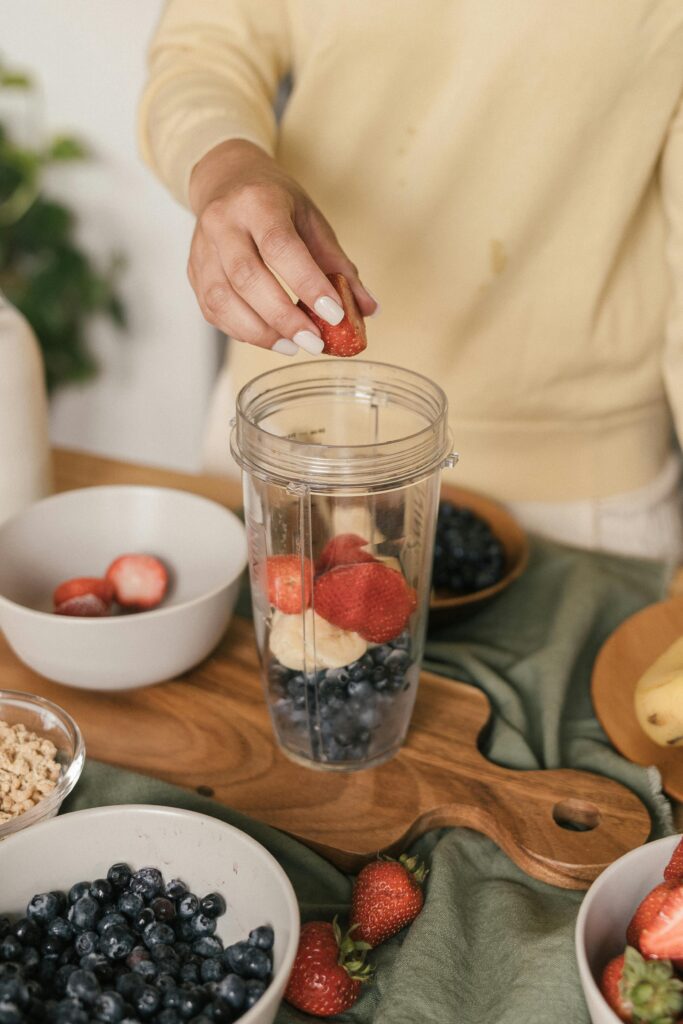While you might worry about the weight of a glass jar blender, consider the benefits it brings to your kitchen over its plastic counterpart. Glass jars don’t hold onto odors or stains as plastic does, ensuring your smoothies and soups remain fresh and untainted.
You’re likely pondering the durability and health implications each type offers, alongside their environmental impact. As you weigh the pros and cons, remember that your choice affects not just the quality of your blends but also the longevity and safety of your appliance.
Let’s explore further to find the best fit for your blending needs.
Material Comparison
When comparing glass and plastic blender jars, it’s essential to consider how their material affects performance, maintenance, and aesthetics. Glass blender jars don’t discolor, scratch, or absorb food odors, maintaining their clarity and cleanliness over time. This means they’ll keep looking new, even after many uses. However, they’re heavier, which can be a downside if you’re blending large batches or prefer a lighter jar. Their weight and durability offer a vintage appeal, adding a touch of elegance to your kitchen.
On the other hand, plastic blender jars are lighter and more affordable, making them a practical choice for those with weak hands or a tighter budget. Despite their convenience, they can become scratched and stained, which might affect their appearance and longevity. This difference between glass and plastic highlights the need to weigh aesthetics against practicality.
In terms of usage, glass jars are more suitable for making smoothies or frozen drinks due to their robustness against temperature changes. Plastic jars, being lighter, are ideal for large batches. Considering your needs and preferences is crucial when choosing between them, factoring in their features and maintenance requirements.
Health Considerations
Beyond aesthetics and practicality, your choice between glass and plastic blender jars also impacts your health. When it comes to what you’re blending your morning smoothie or homemade soup in, the material matters more than you might think. Glass jars are increasingly recognized for their health benefits over their plastic counterparts, and here’s why:
- Nonporous Nature: Glass jars don’t absorb odors or harbor bacteria as plastic can, making them a safer choice for food preparation.
- Chemical Leaching: Unlike plastic jars, glass is free from harmful chemicals like BPA, which can leach into your food, especially when the container is subjected to high blending speeds and temperatures.
- Ease of Cleaning: Glass jars are simpler to keep clean and sterile, significantly reducing the risk of bacteria buildup. Plastic jars, on the other hand, may scratch and become a safe haven for germs.
Choosing a glass jar blender isn’t just about keeping your foods and beverages taste-free from last week’s concoctions; it’s about prioritizing your health. With glass, you’re avoiding the pitfalls of plastic that could potentially impact your well-being over time.
Durability and Lifespan
Considering durability and lifespan, glass jar blenders often outshine their plastic counterparts, offering a robust option for long-term use. Tempered glass, known for its strength, stands up to intense blending cycles without showing the same wear and tear that plastic jars do over time. While plastic jars are lightweight and may appear more cost-effective initially, they don’t hold up as well against the rigors of daily use.
If you’re weighing glass vs plastic, it’s essential to consider how often you’ll be using your blender. High-end blenders, like those from Ninja, often feature glass jars precisely because they’re built to last. They’re designed for longevity and robustness, ensuring that your investment pays off in the long run. On the other hand, plastic jars might start to show their age much sooner, especially with frequent use.
Cleaning and Maintenance
When considering a blender, you’ll find that glass jars aren’t just easier to keep clean, but they also maintain their clarity over time. Unlike plastic, you won’t have to struggle with absorbing odors or fighting stubborn stains.
This ease of cleaning and enduring appearance contributes significantly to the overall durability and maintenance of your blender.
Ease of Cleaning
One of the key advantages of glass blender jars over plastic ones is their ease of cleaning and maintenance. When you’re juggling a busy schedule, you’ll appreciate how straightforward it’s to keep glass jars in pristine condition compared to their plastic counterparts. Here’s why:
- Glass jars don’t absorb odors or flavors, making them a breeze to clean with just a quick rinse and wipe.
- Plastic jars, however, can hang onto residues and smells, necessitating a soak in hot soapy water followed by a scrub.
- Overall, the maintenance of glass jars is simpler due to their non-absorbent nature, saving you time and effort after each use.
Choosing glass jars not only elevates your blending experience but also simplifies your cleanup routine.
Durability Over Time
Let’s dive into how glass jar blenders offer superior durability over time, thanks to their ease of cleaning and maintenance.
Unlike plastic blending jars, glass doesn’t absorb odors or flavors, making them easier to clean and maintain. This means you’re not left with lingering smells or tastes from previous uses, a common issue with plastic blender jars. Stains on glass are also easily removed, ensuring your blender remains pristine and functional for longer.
On the other hand, cleaning plastic jars can be a real hassle, often requiring soaking and scrubbing with a soft brush to remove stubborn stains. The simplicity of maintaining blenders with glass jars makes them a more durable and convenient option compared to their plastic counterparts.
Environmental Impact
Considering the environmental impact, glass jar blenders emerge as the more eco-friendly choice compared to their plastic counterparts. When you’re weighing your options, it’s crucial to understand the broader effects your purchase has on the planet. Glass vs. plastic jar debates often center around personal preference, but the environmental implications are undeniable.
- Recyclability and Lifespan: Glass jars don’t just last longer; they’re also 100% recyclable, reducing the amount of waste that ends up in landfills.
- Pollution: The production of plastic jars generates more pollution than glass, contributing to environmental degradation.
- Sustainable Practices: Opting for glass over plastic supports sustainable practices, helping to cut down on plastic pollution.
You’re not just choosing a blender; you’re making a statement about your commitment to the environment. Glass jars can be repurposed or recycled with ease, making them a far less harmful option. On the other hand, plastic blender jars add to the growing problem of plastic waste, which often finds its way into landfills and oceans, causing harm to wildlife and ecosystems. By choosing glass, you’re taking a step towards a cleaner, more sustainable world.
Cost Analysis
When considering a blender, you’re likely weighing the initial purchase price against long-term value. Glass jar blenders might hit your wallet harder at first, but they’re built to last, potentially saving you money over time. On the flip side, plastic jar blenders offer immediate budget relief, though you might face more frequent replacements.
Initial Purchase Price
Evaluating the initial purchase price reveals that glass jar blenders typically cost more than their plastic counterparts. When comparing glass and plastic, the initial purchase price plays a significant role in your decision-making process. Here’s what you need to consider:
- Glass jar blenders range from $50 to $200, influenced by brand and features.
- Plastic jar blenders start at a more affordable range of $20 to $50.
- Budget and needs should guide your choice between plastic or glass.
While the upfront cost is higher for glass, it’s essential to weigh this against your budget and what you’re looking for in a blender. Remember, the initial purchase price is just the beginning of your consideration between glass and plastic.
Long-Term Value
Despite the higher initial cost, glass jar blenders often offer better long-term value due to their durability and reduced need for replacement. The resilience against scratches, stains, and odors not only preserves their appearance but also contributes significantly to cost savings over time. You’ll find that investing in quality pays off, as the need to replace a glass jar blender becomes less frequent compared to plastic ones.
| Feature | Glass Jar Blender | Plastic Jar Blender |
|---|---|---|
| Initial Cost | Higher | Lower |
| Durability | Excellent | Variable |
| Scratch Resistance | Yes | No |
| Longevity | Longer | Shorter |
| Overall Value | Better | Lesser |
Analyzing the overall cost and durability, it’s clear that glass jar blenders are a prudent choice for long-term savings.
Taste and Odor Retention
One crucial aspect you’ll notice when choosing between glass and plastic jar blenders is how they affect the taste and odor of your blends. Glass jars don’t retain odors, ensuring that the taste of your blends remains pure and unaffected by previous uses. On the other hand, plastic jars have a tendency to absorb odors, which can potentially alter the flavor of your future blends. This distinction is particularly important if you’re someone who values consistency in taste and is sensitive to any changes in flavor profiles.
To keep you interested, here are some key points to consider:
- Glass jars preserve the taste of blended items better than plastic, due to their non-porous nature.
- Plastic jars may require more effort to remove unwanted smells, impacting your blending experience.
- Odor retention in plastic jars can subtly change the overall flavor profile of your ingredients, making glass jars more suitable for odor-sensitive users.
Conclusion
In conclusion, choosing between a glass jar blender and a plastic one comes down to your preferences and needs. Glass jars don’t hold odors or stains and are healthier, but they’re heavier and can break easier. Plastic is lightweight and tough, but it might absorb smells and potentially harm your health.
Both require maintenance, yet glass tends to be more eco-friendly. Ultimately, weigh the pros and cons, considering taste, health, and environmental impact, to make the best choice for you.





